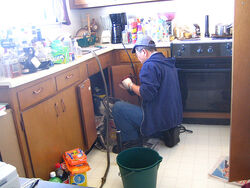No edit summary |
m (moved picture and added link) |
||
| Line 11: | Line 11: | ||
===Drains=== |
===Drains=== |
||
| + | |||
| ⚫ | |||
==Related== |
==Related== |
||
| Line 22: | Line 24: | ||
* [[meter]] |
* [[meter]] |
||
* [[water softener]] |
* [[water softener]] |
||
| + | * [[plumber]] |
||
| − | |||
| ⚫ | |||
==References== |
==References== |
||
Revision as of 00:41, 13 April 2012

a plumber at work
Indoor plumbing is an excellent part of making a home a comfortable place to live. Water comes in through pipes, some of it may be heated by a hot water heater. Then it's used to drink, to clean, to water the plants, etc. After that, excess and used water is taken away to the sewers, septic tank or other waste water system.
While much of it is hidden in the walls, the fixtures that they link to are very much in evidence. As long as everything is well maintained, the plumbing system should last a good while.
Anatomy of Plumbing System
Typically, water enters the house via pipe through some point below the surface of the ground floor. Where there is space beneath the floor, the distribution of pipes is readily evident to anyone inclined to look below. Otherwise most of the pipes are seldom if ever seen as they pass through the walls to get to where the water is needed. With the exception of the Toilet, the Water Heater, and possibly a washing machine, the inbound pipes will always terminate at a faucet. Below any indoor faucet, there should be a catch basin, usually a sink of some kind where the water will most likely be used. When the water is no longer needed, it is then released through a drain into an outbound pipe that eventually brings the used water to the sewer connection, and away from your home.
Maintenance
Faucets
Drains

pipes and water meter
Related
References
- HowStuffWorks? on Plumbing Basics
- HowStuffWorks? on Plumbing Troubleshooting